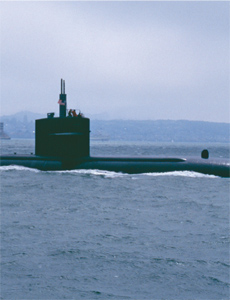Upfront
Floating Nuclear Power Plants Sail Onward
In 2016, the world may see its first floating nuclear power plant. The Akademik Lomonosov will be the first of a fleet planned by the Russian government to produce 70 megawatts of energy using two KLT-40 naval propulsion reactors — enough to power a city of 200,000 people.
 The barges, which will not be self-propelled but instead will be transported by tugboat, will serve remote areas where building a large, permanent reactor may be unnecessary, too expensive, or too dangerous. Primarily, they will serve large industrial companies, oil-drilling platforms, and remote towns in Arctic Russia and the Far East.
The barges, which will not be self-propelled but instead will be transported by tugboat, will serve remote areas where building a large, permanent reactor may be unnecessary, too expensive, or too dangerous. Primarily, they will serve large industrial companies, oil-drilling platforms, and remote towns in Arctic Russia and the Far East.
“We’ve actually had floating reactors for more than 60 years,” in the form of submarines, commercial ships, and aircraft carriers, said Dan McGarvey, U.S. Energy, Mining and Power Practice chairman at Marsh, Inc. in Greenville, S.C.
“Today, there are 93 floating reactors anchored near San Diego, Norfolk, Seattle, Honolulu and other populous areas,” he said.
Russia is already active in operating mobile nuclear reactors on its icebreakers. The key difference is that the new floating plants won’t use any power for their own propulsion — their purpose is to produce available electricity.
Critics of the plants question their safety and see an environmental threat, citing the possibility of nuclear materials contaminating surrounding waters and marine life. Manufacturers, however, claim that the floating plants will be developed with a safety margin, designed to withstand collisions and ride out tsunamis. They are intended to be failsafe.
“These are next-generation reactors, not your father’s reactors,” said McGarvey, an expert in insuring nuclear power plants. “They use a series of systems that rely on gravity, natural circulation, and stored energy such that if the reactor loses all power, those systems don’t require power to operate.”
The challenge at Fukushima — where the reactor at the nuclear power plant in Japan melted down and released radioactive materials — was that the earthquake and tsunami knocked out all power, including backup diesel generators, leaving the plant without any way to circulate cooling water to the reactor.
The system of natural forces in place on the floating reactors would keep water pumping and circulating, and can keep the reactor from having core damage for 72 hours without human intervention, according to McGarvey. A floating vessel would also stand a better chance of riding out an earthquake or storm, compared to a structure anchored in bedrock.
“These are next-generation reactors, not your father’s reactors.”
— Dan McGarvey, U.S. Energy, Mining and Power Practice chairman, Marsh
The Akademik Lomonosov and similar vessels could also each save 200,000 tons of coal per year, McGarvey said, sparing the environmental risks of coal-burning.
A major risk of utilizing floating plants, however, is one of security. It would be much easier to sabotage, hijack, or launch an attack from a vessel sitting just offshore, than from a landed facility.
Despite the apparent benefits of moving nuclear power generation offshore, the barges cannot sail without sufficient insurance coverage.
“P&I coverage is available in commercial markets, but can have nuclear exclusions,” McGarvey said. “It exists more to address things like grounding and collisions.” The ships will need to amass coverage from the global nuclear pool for decontamination, which poses the greatest challenge.
“The [Vienna Convention on Nuclear Liability] holds the government accountable for meeting certain standards,” McGarvey said.
“The owner/operator is solely responsibility for liabilities arising from a radiological standpoint to third parties,” he said. “They are required to meet a minimum insurance limit of $350 million of liability coverage. Above that level, the government is held to account by this treaty. And the barges will be owned by the Russian government, which seems to have no intent to sell them.”










